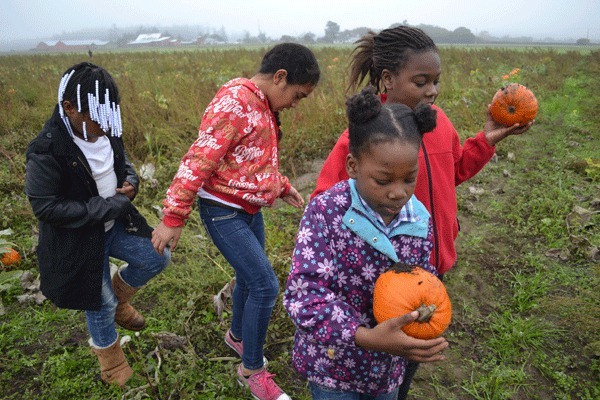Even though the fog lingered over the pumpkin patch, two girls were still able to scout for the perfect pumpkins.
“I’m looking for the perfect shape because I’m going to get lights and put them in it,” Rammaya, 9, said.
Rammaya carefully examined every other pumpkin she passed until she found the perfect shape she was looking for.
Her friend had a different tactic.
“I love the baby ones. I always like to find baby things,” Rmani, 6, said.
Rmani’s search led her to a pumpkin that could almost fit in the palm of her hand.
Thursday, Oct. 24, about 35 kids from First Place school in Seattle visited Sherman’s Pioneer Farm Produce in Coupeville to tour the pumpkin patch.
“Even getting here, most of them haven’t been on a ferry before,” said Miriam Reed, First Place head teacher. “Most probably haven’t driven down a country road before.”
First Place is an organization providing education and advocacy for children whose families struggle with homelessness and help them achieve stability. It opened in 1989 as a transitional school for children whose families were living in transitional housing and homeless shelters.
At the time, children had to have a permanent address to enroll in public school. Now First Place offers elementary education for first through sixth grades.
As soon as the vans pulled up, the students exploded out of the doors with excitement.
“They listened to music, and I showed them a few funny YouTube videos, but most of them slept all the way up here,” said Tanya Coon, a first and second grade teacher at First Place.
Coon attended the field trip last year and said everyone at the school was excited to come up to the farm again.
Windermere Real Estate in Coupeville sponsored the trip last year, and wanted to do it again, said Alix Roos, the trip’s organizer. They covered the costs of the vans and the ferry ride up to the farm.
“It’s a privilege for us and the kids to be here,” Roos said. “These kids and teachers are heroes.”
Roos used to live in Seattle and volunteered for First Place for five years. Her uncle, Dale Sherman, owns the farm and she thought it would be a perfect place for the school to visit. She fell in love with the kids and wanted to do something special for them.
“I want them to have this experience,” Roos said. “We’re here again and I hope we can do that every year.”
Ever Green Building, owned by Roos’ husband Brandon Roos, sponsored the lunch, which was made by Serendipity Catering. The students fueled up on macaroni and cheese, apple sauce, carrots, chocolate milk and cookies before taking to the pumpkin patch.
Sherman took the kids on a tractor ride to the pumpkin patch, where they could pick out one pumpkin to take back home. The only stipulation was they had to carry it themselves.
Trips like this are valuable to the students’ education, Reed said. Visiting the farm teaches them where food comes from and gives them a context for what things are and how they’re used.
“It’s also realizing that pumpkins don’t grow on store shelves,” Reed said.
Out in the pumpkin patch, teachers were pointing out the squash blossoms and explaining to the children that’s how pumpkins start off. Reed said it’s a huge expansion for their vocabulary. In stories the students read, they can’t identify with some of the settings because they’ve never seen them. Now that they have this experience, they can refer back to it.
“First hand knowledge is crucial for these kids,” Reed said.
All the students could not stop running to each new thing they saw. The boys immediately were drawn to the cows, but left quickly after discovering that they were “stinky.”
One thing the teachers showed the students is that it’s OK to get dirty. They’re used to be around asphalt, so they’re more tentative around dirt, and the instructors try to break that barrier, Reed said.
At first the students shied away from the dirt, but after some time in the pumpkin patch, a few were even starting to put worms in their pockets to bring back home.
After they all picked out their pumpkins, it was time togo. The students piled into the vans, and a chorus of thankyous followed suit.



